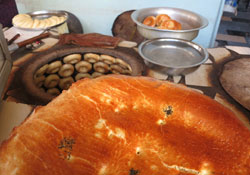Taking steps towards reducing trans fat and salt in Tajikistan

A newly published WHO report on food found in and around the markets of Dushanbe, Tajikistan, reveals both positive and worrying results, and shows that the nutritional composition of the food and drinks on offer could be drastically improved.
Markets, bazaars and street trade have always been well developed Tajikistan, a stop on the ancient Silk Road. However, some of the food being offered in these settings contributes to increased risk for serious illnesses.
The study results show alarming levels of sodium and trans fat in much of the food. Trans fat and sodium, most commonly consumed in salt, increase the risk for cardiovascular diseases such as stroke, hypertension and heart attacks.
Noncommunicable diseases (NCDs) cause half of all deaths
While communicable diseases, maternal, infant and child mortality, and nutritional deficiencies account for a sizeable proportion of the overall number of deaths in the country, NCDs are by far the leading cause of death – and the overall burden of NCDs is growing.
Cardiovascular diseases, cancer, respiratory diseases and diabetes now account for more than 50% of all deaths in Tajikistan. A third of the population over 20 years of age is either overweight or obese; overweight and obesity contribute to the risk of NCDs and are directly linked to daily food intake.
The “bad” fat
Much of the foods found on the streets of Dushanbe – both processed foods and those made by hand – have a high content of trans fat. The per-serving content of trans fat is highest in industrial wafers, which the study found contained 111.6% of the maximum recommended daily intake.
Trans fat has been linked to an increased risk of cardiovascular diseases. WHO is advocating for a complete elimination of industrially produced trans fat from the global food supply.
Based on this recommendation, public authorities in several countries have already effectively banned their use through legislation.
A very salty meal
Most dietary intake of sodium is from salt added while cooking or from processed foods. WHO calls for a significant reduction in sodium intake worldwide, and recommends the consumption of no more than 5 g of salt (2 g sodium) per day.
The study found that a single serving of homemade soup sold as street food contained 2.5 g of sodium. This is 124.5% of the maximum recommended daily intake in a single meal.
Sugary drinks
Soft drinks are the most commonly sold beverages on the streets of the Tajik capital. This is a concern in view of their high sugar content, which is known to be the main source of added sugar in the diet.
So-called free sugars are monosaccharides and disaccharides added to foods by the manufacturer, cook or consumer, as well as sugars naturally present in honey, syrups and fruit juices. WHO recommends a reduced intake of these free sugars throughout the life-course as they contribute to excess energy intake and weight gain.
Traditional and widely accessible food
Street food is diverse and constitutes a widely accessible, inexpensive source of food, especially in urban areas of low- and middle-income countries.
While it is often rich in fat, sugar and sodium, street food also brings great benefits. It plays an important role in strengthening the community and protects traditional foods and diets. Crucially, fruit and vegetables – an essential part of a healthy diet – are widely available in and around markets in the city.
Various policy options could be adopted to ensure healthier street food, while maintaining the important cultural and community role that market vendors play. Creating legislation to prohibit the use of trans fat and encouraging producers and vendors to use less salt and sugar are among the WHO recommendations.
Details on report
Growing urbanization and the globalization of processed food have resulted in dietary changes, with more frequent intake of processed foods that are energy-dense and rich in fat, sugar and salt. Yet previous research on street food mainly addressed food safety rather than its nutritional contribution to local diets.
The new report is part of the FEEDCities project, an effort to bridge this knowledge gap. It was made possible by funding from the Government of the Russian Federation within the context of the WHO European Office for the Prevention and Control of Noncommunicable Diseases.



